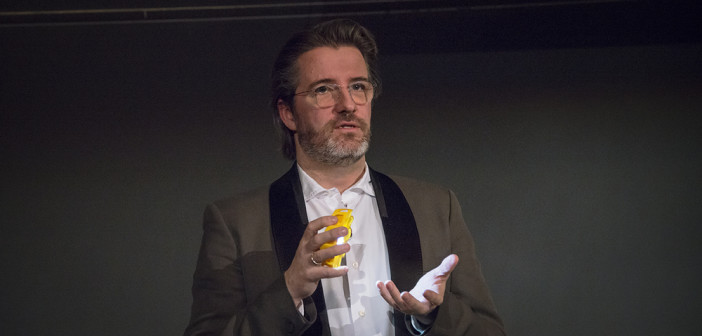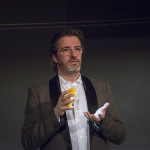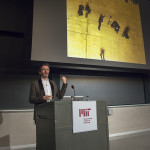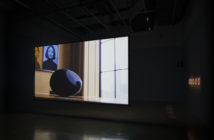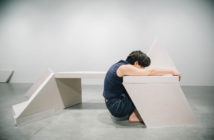- Olafur Eliasson
The first time I attended an Olafur Eliasson speaking engagement was at the Education + Activism Salon at Miami Basel in December of 2013. Eliasson was joined by Klaus Blesenbach, Director of MoMA PS1 to discuss the social business and emerging global project, Little Sun—a functional, high-quality solar-powered LED lamp developed in collaboration between Eliasson and engineer, Frederik Ottesen. Little Sun is a self-proclaimed "social business" with the aim to sustain a global wave of connecting the world by sharing, delivering, and sustaining an affordable, reliable light source for off-grid communities.
The conversation between Eliasson and Blesenbach organically shifted to art’s ability to act as a catalyst for social justice. At a more fundamental level, the abstract ideas and critical dialogue that provoke exploration is a source of confidence and freedom for young artists that is hard to teach. It is learned naturally, through persistence and pursuit of one’s practice. I was struck over the head (hard) with a blunt statement made by Eliasson, "Young artists are so talented, but in a way, they are also traumatized." He went on to elaborate, citing that the decision to pursue the arts as a language for engagement, in or out of art school, is a huge risk. It is unrelenting to invest in a passion as abstract and contested as art. Be it painting or curating or whatever discipline, the course is never defined. It is unclear and less concrete to commit to a practice that is continuously evolving, adjusting, and influencing a global perspective. And yes, while it is true other fields such as medicine evolve with new discovery, the absolute fact does not exist in art. To grow with a field that is still defining its own language and objectives is hard—and it demands confidence in order to persevere. As a result of Eliasson’s phrase, I became acutely aware of how much of his practice is a platform for education and empowering diversified youth to explore abstract thinking.
Olafur Eliasson and I crossed paths again, this time at the MIT public lecture "Holding Hands With the Sun" in honor of his recent Eugene McDermott Award in the Arts. On the surface, Eliasson’s lecture re-introduced the audience to Little Sun and reviewed a retrospective of his work. The audience was an assemblage of Boston-area artists, curators, scholars, students, engineers, philanthropists, etc. gathered from diversified fields. Together, a cultural geography of what collaboration looks like was formed that evening. Looking back, the crowd was a reflection of Eliasson’s think-tank studio model. Eliasson works with a cohort of interdisciplinary collaborators such as "slow walkers", art historians, engineers, designers, food researchers, architects, and color experts to name a few. Although each background is different, the participants who impose their disciplines onto each project are quite interdependent. There is an inherent understanding that thinking abstractly is valued and, dare it be said, encouraged.
As a fairly recent Boston-area transplant working at an arts institution, I am continually reminded of the "risks" taken by the students I encounter daily and the "trauma" they face as budding artists. Eliasson’s studio practice has informed my social responsibility as a curator to the community of young artists with whom I engage. Artists and the projects they cultivate, like Eliasson and Little Sun, are macro reminders to the seemingly microcosm of students whose minds think abstractly. And while it is hard to drown out the noise of financial debt and questions like, "How will you make a living with an degree in Art?" a louder question resonates from the cultural shift spurred by Eliasson. He said it best during his MIT lecture: Rather than asking how? Ask why?
It is essential, in every stage of artistic growth and/or practice, to have the confidence to ask why. Why communicate through the language of medium? Why is conceptual thinking critical? Why is my stake in creative expression a valued pursuit? All of these questions relate to the ability to think abstractly and embracing the necessity to do so with confidence. Contrary to what a general public might think, it is a necessity. Abstract thinking is a fortuitous, viable skill. The generalization is to think of art in less than concrete terms because as a language, its communication is multi-layered.
I used to think that my responsibility as a curator and educator in the arts was to pass along little nuggets of truth. However, "Holding Hands With The Sun" has redirected my understanding of freedom and responsibility. The language of a "me" perspective that asks what the singular "I" can exchange with "you", assumes an exclusive, elitist engagement. Rather, as evidenced in the studio practice of Eliasson and in the mood of the room that evening at MIT, multiple voices contribute to a participatory productivity combining this idea of freedom and responsibility.
In the end, the aesthetic beauty and cultural richness that comes from such conceptual thinking is what bridges the gaps between individual and community. I am fortunate enough to work in a place that facilitates a space where the aim can be about the experience and my language as a curator of desire and creativity is encouraged. It remains, however, a collective responsibility, to encourage one another to be confident in our independent thinking and continue to ask why.
- Photo by L. Barry Hetherington
- Photo by L. Barry Hetherington
- Photo by L. Barry Hetherington

